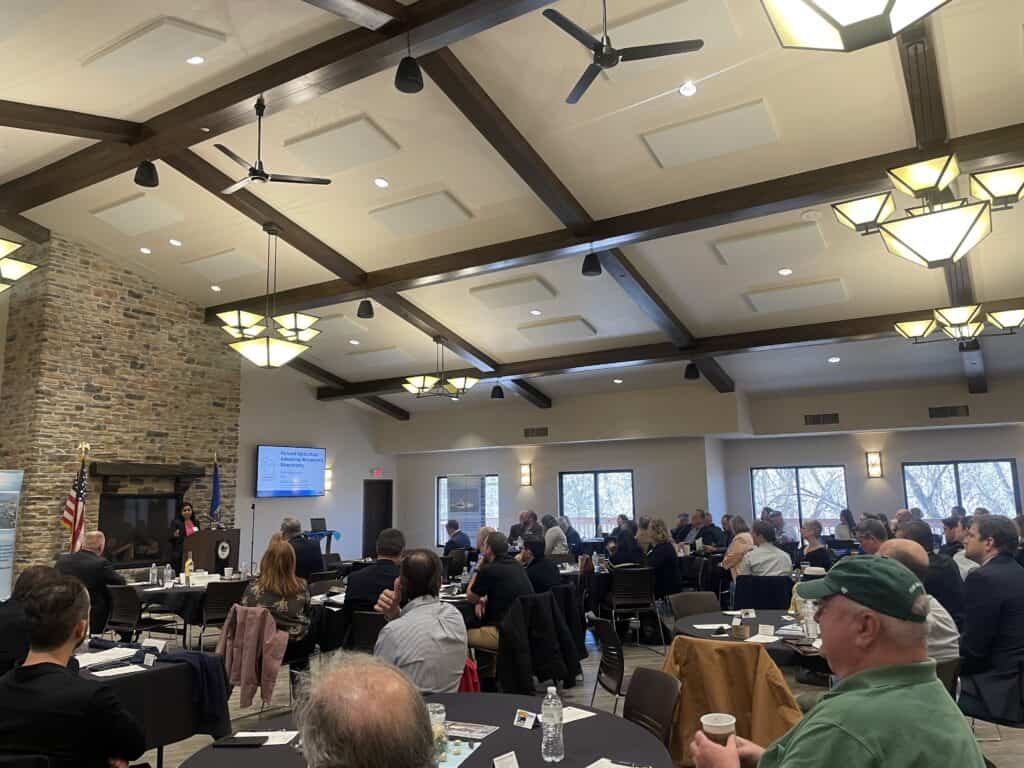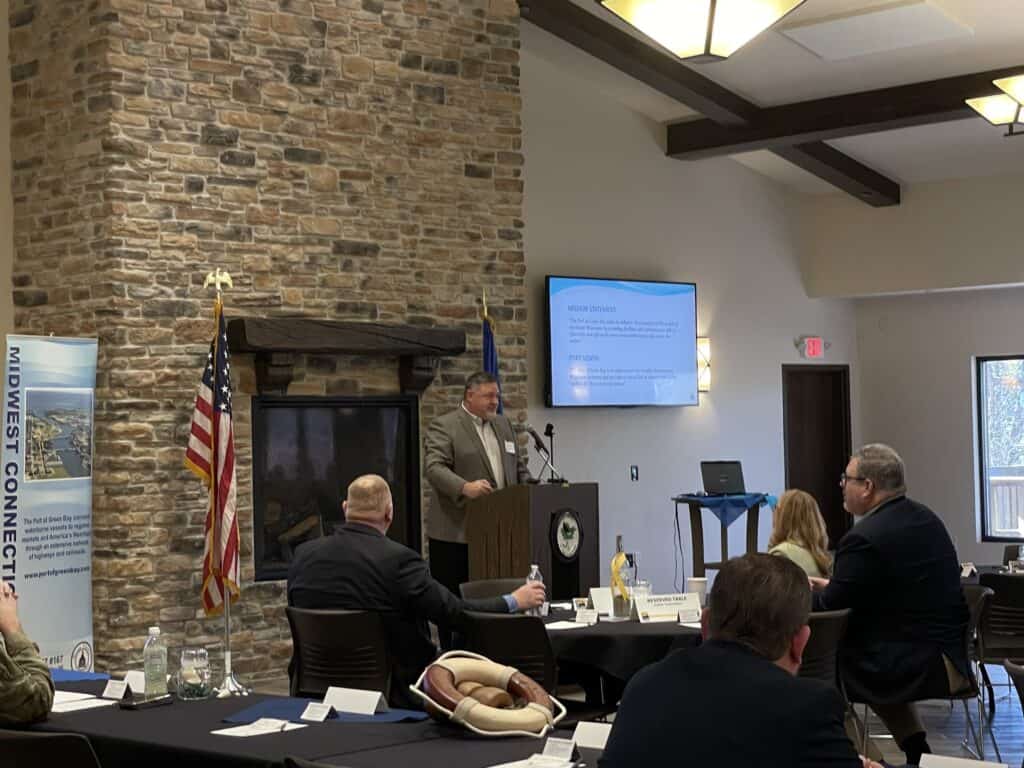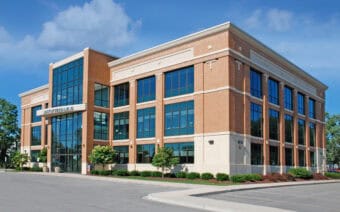
May 5, 2025
GREEN BAY – Local, state and federal leaders stressed the importance of a strong Great Lakes maritime economy and its impact on Northeast Wisconsin at the 2025 Port Symposium held late last month in Green Bay.
“We walked away with a lot of valuable insights from this year’s symposium,” Dean Haen, Brown County Port of Green Bay director, said.
Haen said each symposium speaker – which included Brown County Executive Troy Streckenbach; Harbor Commission Vice President Bryan Hyska; U.S. Congressman Tony Wied (8th District); Col. Kenneth Rockwell with the U.S. Army Corps of Engineers; NEW Manufacturing Alliance Executive Director Ann Franz; WiSys Director of Strategy and Innovative Ventures Adhira Sunkara; Brian Oszakiewski, executive director of the American Great Lakes Ports Association (AGLPA); Dr. Marc Schaffer of St. Norbert College; and U.S. Senator Tammy Baldwin (via video) – provided a “deeper understanding of the dynamic factors that are shaping our regional economy.”
Though there may be unknowns, many of the speakers said businesses remain upbeat about the economic outlook for the region.
Port review
Hyska kicked off the symposium with a look at the numbers, comparing the cargo totals of 2024 compared to those of 2025.
According to Hyska, the Port of Green Bay – which has 14 active port businesses spanning more than three miles of the Fox River – passed through 1,695,718 metric tons of product in 2024, down 7% from 2023.
Though there was a decrease in tonnage, he said the port saw a 6% increase in vessels in 2024, with a total of 181 ships entering the port – up from 2023’s 171.
Hyska said not all products saw a decrease in tonnage.
Domestic imports of cement, coal and liquid asphalt, he said, saw an increase, while salt, petroleum and limestone saw decreased numbers.
At the symposium, Hyska took a moment to reiterate some of the highlights of the port’s most recent economic impact study, such as:
- $217.3 million in economic activity generated by the port
- 1,620 Wisconsin jobs supported by the port
- Direct personal income paid reached $41.7 million
- Induced and indirect income exceeded $142 million
- Port activities resulted in $38 million in local, state and federal taxes
Hyska also shared with attendees the mission statement and vision of the port:
- “The Port of Green Bay exists to enhance the prosperity of the people of Northeast Wisconsin by providing facilities and infrastructure able to effectively and efficiently move commodities and goods across the nation.”
- “The Port of Green Bay is an integral part of a healthy Northeastern Wisconsin economy and provides a critical link to national and global markets for Wisconsin enterprises.”
The 2025 shipping season, Haen said, started March 12 – just two days later than 2024’s start – with the arrival of the Innovation with tug Samuel De Champlain, which was carrying a shipment of cement.
As the western-most port of Lake Michigan, Haen said the Port of Green Bay offers a direct route for shipping from the Midwest to the rest of the world.
Manufacturing sector
The symposium also included an update from Franz regarding the region’s manufacturing sector.
According to the alliance’s 15th annual Northeast Wisconsin Manufacturing Vitality Index, manufacturing – which Franz said makes up 23% of the region’s employment base – remained strong over the last year.
Franz said some of the key takeaways of the survey, which was administered last October-November by the University of Wisconsin-Oshkosh’s Center for Customized Research Services – include:
- 93% of respondents said their company was financially healthy
- 65% are expecting increased sales in 2025
- 47% of respondents reported their supply chain was impacted in 2024 – a significant decrease from 2023’s 61% and 2022’s 98%
- Over half expect to invest in plant modernization in 2025
- More than 40% reported they planned to hire in Q1 and Q2, and nearly 40% planning to hire in Q4 of 2025
Franz said the survey showed nearly a 50-50 split of companies currently using and not using AI.

For those respondents who checked they were hesitant about using AI, Franz said the top reasoning was a lack of experience, followed by complexity with integration.
In terms of workforce, the survey highlighted machinists and CNC machinists as the most difficult-to-fill positions.
Fifty-eight percent of respondents noted that they anticipate difficulty in locating and acquiring talent – which Franz said is a significant increase from the 29% of companies who anticipated hiring difficulties in 2011, the first year of the survey.
Shipping is foundation of the regional economy
Founded in 1977, Oszakiewski said the AGLPA represents the interests of commercial ports and port users on the United States side of the Great Lakes, and works to influence public policies with the goal of fostering maritime commerce and related employment in the Great Lakes region.
Serving as a foundation for the regional economy, Oszakiewski said the AGLPA represents 15 commercial port agencies, including Green Bay, that serve the steel-making, agriculture, energy and mining industries.
From a legislative perspective, Oszakiewski discussed a handful of current issues with potential impacts on the port, including:
- Port infrastructure grant funding – received grant from the U.S. Department of Transportation
- Chinese-built vessel port fee – could lead to increased costs for shipping firms
- Harbor maintenance funding – received $2.1 million to install a dock wall, dredge, fill behind a bulkhead and regrade property to create a new transload facility at the mouth of the Fox River
- Soo Lock construction – which is underway now
- Icebreaking – the Great Lakes Winter Commerce Act will codify the icebreaking mission and set performance standards
- Marine pilotage rates – which saw a 7% increase over 2024
- Environmental issues
Tariffs
Schaffer – the event’s final speaker – shared a comparative overview of tariffs from both the current and previous administrations.
According to his assessment, though GDP has remained fairly solid and consumer spending has kept the economy strong, key economic indicators to watch over the coming months will be consumer, business and government spending as well as exports.
“Despite headwinds, real GDP has continued its resiliency with 2.8% growth in 2024,” he stated at the symposium. “Consumer resiliency continued to drive economic growth in 2024.”
Schaffer said unemployment consistently hovered around 4% in 2024, and inflation is down from recent highs and heading toward pre-COVID-19 pandemic rates – “at the moment.”
Regarding the known unknowns, Schaffer said trade policy and tariffs are driving the economic agenda at the moment, and the final implementation of this policy will have a substantial impact on the U.S. economy in the short run and long run.
Trade deficits, he said, are not new for the U.S., and a large majority of U.S. trade takes place with a handful of key trading partners.
“The U.S. has consistently run trade deficits,” he stated at the symposium. “However, these are really driven by goods, while the U.S. runs a trade surplus in services.”
According to Schaffer, in 2024, Wisconsin imported $38.8 billion worth of goods, while exporting $27.5 billion in goods.
According to a tariff impact case study Schaffer presented at the symposium, U.S. imports from China have fallen significantly in all three groups of goods after tariffs were imposed.
U.S. exports to China, he noted, also declined after China imposed retaliatory tariffs.
Furthermore, in the case study, Schaffer noted that after tariffs were implemented, the price of U.S. soybeans fell while Brazilian soybean prices increased.
As U.S. soybean exports to China dropped to near zero, he said Brazilian soybean exports to China increased.
“Uncertainty is peaking across the board in 2025, which will soften short-term economic performance in the U.S.,” Schaffer stated at the symposium.
 New FVTC training grants help businesses build talent in-house
New FVTC training grants help businesses build talent in-house Lamers Dairy takes home two first-place awards at World Dairy Expo
Lamers Dairy takes home two first-place awards at World Dairy Expo








